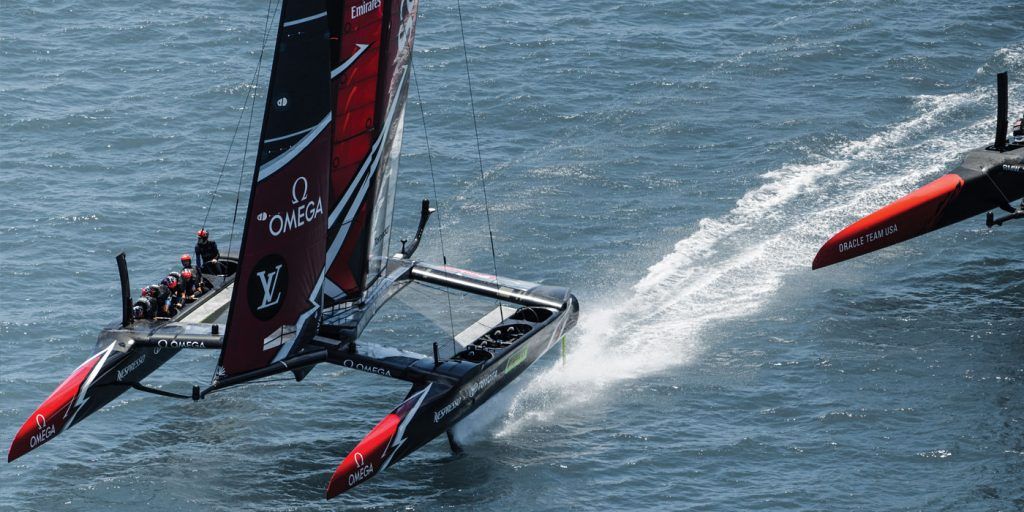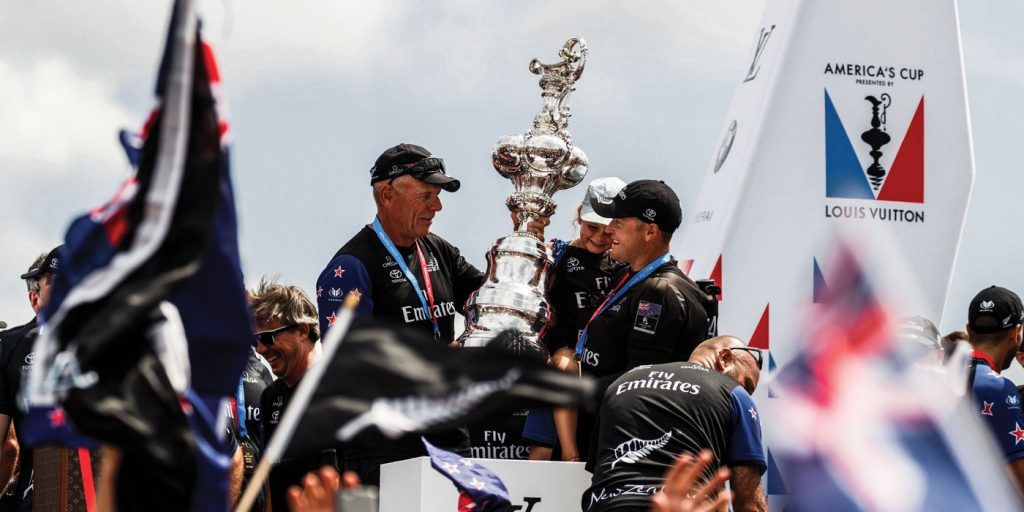The Ultimate Redemption Story
As clichéd as it sounds, Emirates Team New Zealand’s America’s Cup triumph in Bermuda is the ultimate redemption story. Whatever drove the team in the early days after the catastrophe in San Francisco four years earlier was potent enough to push them through a myriad of challenges and, against all odds and rationale, put together the campaign to beat all campaigns. How did little old New Zealand topple the American giant?
 Beating Oracle Team USA 7-1 to claim the 35th America’s Cup completed the most epic of turnarounds as Emirates Team New Zealand (ETNZ) were lucky to even be in Bermuda. Picking themselves up off the San Francisco canvas was the first step they had to take and it would have been easy for maligned team head, Grant Dalton, to slip into obscurity – a footnote on the pages of arguably the worst sporting choke known to man. Post 2013, Kiwis just wanted to forget about anything yachting; the yachties had had their time in the sun and the All Blacks were there to fall back on. In a way, the apathy for the ‘rich white man’s sport’ would suit Dalton as he dusted himself off and got to work. Soon after the 2013 debacle, Dalton and the team that remained began the reconstruction with a ‘brutal’ recovery process that pulled no punches when it came to exactly what went so wrong. Losing eight straight races to be defeated 9-8 was an atomic blow. Truths were told and the failed campaign stripped bare, with 20 major points identified as needing serious work. Design was at the top of the list. As the fallout continued, ETNZ talisman since 2003, Dean Barker, got the chop and that was close to the last the public would hear of it. Thank goodness, many decided. After Barker was mercilessly dumped, so began the vital task of retaining key players. Wages had to be paid and money was the only currency that would keep any part of the team intact. Dalton used his contacts and commercial nous to trawl for sponsorship. The New Zealand government wasn’t an option any longer and much of the budget would be courtesy of The Warehouse founder Sir Stephen Tindall, Swiss Italian businessman Dr Matteo de Nora and a swath of commercial sponsors. Tindall was no stranger to ETNZ and had donated a genoa sail to the breakthrough cause in 1995. Design-wise, ETNZ reluctantly followed the direction Oracle were taking the 35th America’s Cup in and, although Dalton would repel much of his rival’s ideas and edicts for the 2017 regatta and beyond, he attended the lead-in events. There was nothing to suggest at this stage that ETNZ would be anything more than competitive as they never dominated. They kept a low profile and under the radar of both their own countrymen and also their rivals as Bermuda neared. Budget constraints were arguably a convenient front, but the decision to test and train in Auckland would have spinoffs. ETNZ honed their design and functionality and had the freedom to experiment with sailing technology that every other syndicate was trying to get their heads around. Away from prying eyes, Dalton’s sailing team could keep some tricks up their sleeves when the Louis Vuitton series kicked off.
Beating Oracle Team USA 7-1 to claim the 35th America’s Cup completed the most epic of turnarounds as Emirates Team New Zealand (ETNZ) were lucky to even be in Bermuda. Picking themselves up off the San Francisco canvas was the first step they had to take and it would have been easy for maligned team head, Grant Dalton, to slip into obscurity – a footnote on the pages of arguably the worst sporting choke known to man. Post 2013, Kiwis just wanted to forget about anything yachting; the yachties had had their time in the sun and the All Blacks were there to fall back on. In a way, the apathy for the ‘rich white man’s sport’ would suit Dalton as he dusted himself off and got to work. Soon after the 2013 debacle, Dalton and the team that remained began the reconstruction with a ‘brutal’ recovery process that pulled no punches when it came to exactly what went so wrong. Losing eight straight races to be defeated 9-8 was an atomic blow. Truths were told and the failed campaign stripped bare, with 20 major points identified as needing serious work. Design was at the top of the list. As the fallout continued, ETNZ talisman since 2003, Dean Barker, got the chop and that was close to the last the public would hear of it. Thank goodness, many decided. After Barker was mercilessly dumped, so began the vital task of retaining key players. Wages had to be paid and money was the only currency that would keep any part of the team intact. Dalton used his contacts and commercial nous to trawl for sponsorship. The New Zealand government wasn’t an option any longer and much of the budget would be courtesy of The Warehouse founder Sir Stephen Tindall, Swiss Italian businessman Dr Matteo de Nora and a swath of commercial sponsors. Tindall was no stranger to ETNZ and had donated a genoa sail to the breakthrough cause in 1995. Design-wise, ETNZ reluctantly followed the direction Oracle were taking the 35th America’s Cup in and, although Dalton would repel much of his rival’s ideas and edicts for the 2017 regatta and beyond, he attended the lead-in events. There was nothing to suggest at this stage that ETNZ would be anything more than competitive as they never dominated. They kept a low profile and under the radar of both their own countrymen and also their rivals as Bermuda neared. Budget constraints were arguably a convenient front, but the decision to test and train in Auckland would have spinoffs. ETNZ honed their design and functionality and had the freedom to experiment with sailing technology that every other syndicate was trying to get their heads around. Away from prying eyes, Dalton’s sailing team could keep some tricks up their sleeves when the Louis Vuitton series kicked off.
LOUIS VUITTON CUP – ETNZ CAMPAIGN CLOSE TO COLLAPSE
No one quite knew what to expect at the start of the Louis Vuitton challenger series, but for Kiwi fans – both fickle and diehard – there was the expectation ETNZ would be at least competitive. Winning interest or to see it waning would hang on how the boat performed, pure and simple. Quietly confident, ETNZ went about their business, but of concern to everybody (except themselves), Burling was beaten at the start and finish twice by James Spithill, with Oracle controversially involved in the challenger series. An on-water version of chicken ensued in race two between the syndicates and Burling lost his nerve and gave away a penalty. The casual bystander had reason to be uneasy about the Kiwi team’s chances if they reached the America’s Cup proper, even though they qualified for the semi-final series in top spot. Oracle had the wood on them and a convenient carryover point.
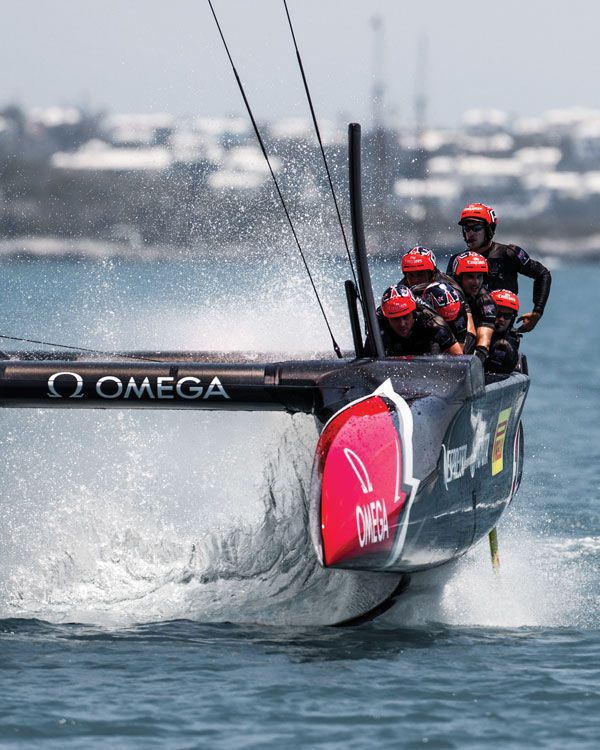 Unease would then morph into neurotic anxiety in the fourth race of ETNZ’s semi-final against British entry BAR. Serious questions were posed about the 25-knot winds being too hazardous for the flying boats and ETNZ’s horrific capsize justified the wariness. As they attempted to get up on their foils, the wind forced ETNZ to pitch up, bow first, into the water, throwing three of the crew into the Bermuda drink. The three remaining sailors teetered in their perilous vertical positions waiting for rescue. After the smoke cleared and the safety of the crew was confirmed, the dollar value of the damage was as distressing as the time cost. Surely there was no way ETNZ could repair the considerable damage to the wing, fairings, electronics and be able to race ably the next day? Cue the increasingly strong winds and the team was gifted an extra 24 hours to patch up the vessel, as the following day’s racing was postponed. The integrity of the ETNZ hull was crucially intact and team BAR couldn’t take advantage of a wounded opponent. Back on the Sound and the recovery from the near-terminal crash was a regatta story for the ages and the team would only drop one more race in accounting for Sir Ben Ainslie’s BAR 5-2 to reach the Louis Vuitton final. After the British boat had ramrodded them in practice, this was a sweet nugget of justice. Sweden’s Artemis came from behind to reach the final and pushed ETNZ hard over the first two days before Burling and co stormed away to complete another 5-2 rout. A magnum or two of sponsor’s product was uncorked after the win, but it was for show; the team knew they hadn’t yet done the job. The only question to be answered at that time was, could they beat Oracle? Those outside the team had their doubts, but would soon see for their own eyes the true genius of Peter Burling and his team of underdogs.
Unease would then morph into neurotic anxiety in the fourth race of ETNZ’s semi-final against British entry BAR. Serious questions were posed about the 25-knot winds being too hazardous for the flying boats and ETNZ’s horrific capsize justified the wariness. As they attempted to get up on their foils, the wind forced ETNZ to pitch up, bow first, into the water, throwing three of the crew into the Bermuda drink. The three remaining sailors teetered in their perilous vertical positions waiting for rescue. After the smoke cleared and the safety of the crew was confirmed, the dollar value of the damage was as distressing as the time cost. Surely there was no way ETNZ could repair the considerable damage to the wing, fairings, electronics and be able to race ably the next day? Cue the increasingly strong winds and the team was gifted an extra 24 hours to patch up the vessel, as the following day’s racing was postponed. The integrity of the ETNZ hull was crucially intact and team BAR couldn’t take advantage of a wounded opponent. Back on the Sound and the recovery from the near-terminal crash was a regatta story for the ages and the team would only drop one more race in accounting for Sir Ben Ainslie’s BAR 5-2 to reach the Louis Vuitton final. After the British boat had ramrodded them in practice, this was a sweet nugget of justice. Sweden’s Artemis came from behind to reach the final and pushed ETNZ hard over the first two days before Burling and co stormed away to complete another 5-2 rout. A magnum or two of sponsor’s product was uncorked after the win, but it was for show; the team knew they hadn’t yet done the job. The only question to be answered at that time was, could they beat Oracle? Those outside the team had their doubts, but would soon see for their own eyes the true genius of Peter Burling and his team of underdogs.
AMERICA’S CUP – BURLING SCHOOLS THE PITBULL
Oracle helmsman James ‘Pitbull’ Spithill had the mental edge right up until the first start of the America’s Cup finals, and for good reason. He was 2-0 through the round robin and had the guillotine raised and ready from the San Francisco heartbreak. ETNZ supporters had pure hope but little else. Race one arrived four days after the Louis Vuitton final and no one saw what was coming. Surprisingly to most, Spithill duffed the first start, was penalised and Burling foiled away into the distance and a dominant first mark lead. The Kiwi boat powered into its work and was 2-3 knots quicker over the first day and the almost-90-second win in Race two was enormous, psychologically. It was a serious dent in Oracle’s morale and the repeat on day two would be just as demoralising. Notwithstanding the contentious bonus point ETNZ had to erase, the four wins on the trot gave the challengers a healthy 3-0 lead. ETNZ fans started to believe… with deep nostalgic caveats, however.
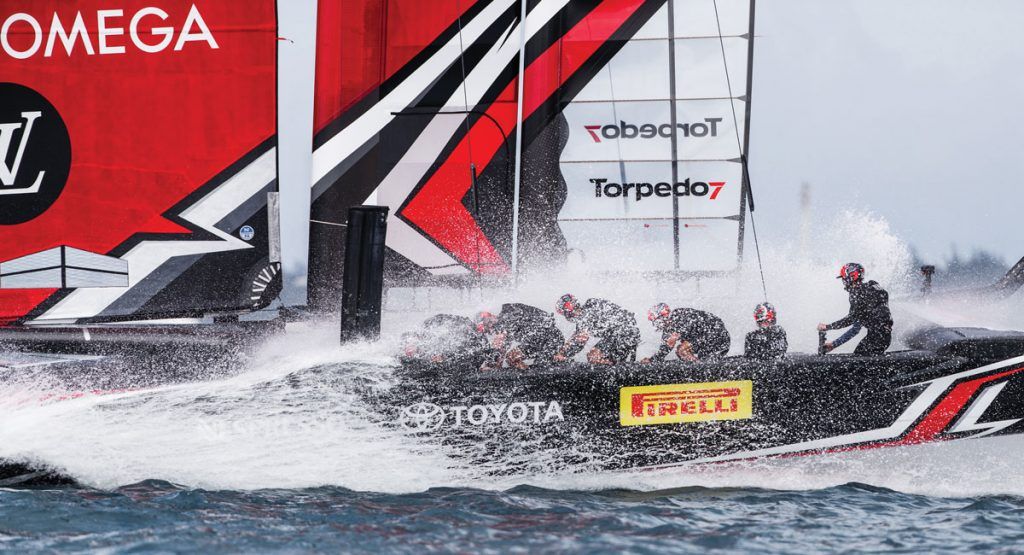
ETNZ would have to wait to inflict more pain on Spithill. One of Dalton’s main bugbears was the rule book being tweaked to the defender’s advantage and the planned five-day hiatus after two days of sailing lifted eyebrows. While ETNZ had the same time to improve their performance, Oracle would benefit more from the layoff. Upon resumption of racing, Oracle was discernibly quicker in a straight line but would be muzzled by two penalty infringements gifting race five to ETNZ. Race six, though, promptly put those in ETNZ’s corner on notice. Not again!? Spithill was relatively restrained in front of the media after the first Oracle win of the series, perhaps because it was clear that a Burling error had gift-wrapped the race to Oracle. The 26-year-old Kiwi put any hint of mental weakness under pressure to bed the very next day and pulled off two clinical race starts, including the now iconic ‘hook’ move that reduced Oracle to a stagnant mess in race eight. Two more comfortable wins and even Spithill couldn’t muster any real fighting talk. He had gone gun shy by his cock-a-hoop standards. Even at 6-1 up and on match point, memories were vivid and long enough to be nervous… for the fans at least. Logic suggested that Oracle had no more ammunition to fire and even Spithill wasn’t anywhere near as verbally antagonistic as he’d been in San Francisco. It appeared he knew the outcome – and so did the Kiwi crew.
On the final day of racing, ETNZ couldn’t quite pinch the start and rounded the first mark only one boat length behind. It didn’t take long before ETNZ gybed smartly and passed Oracle early on the second leg and were never headed, cruising over the finish line to win by 55 comfortable seconds. Relief and ecstasy were in equal measure, but what was the secret to crushing the financial might of Oracle?
SECRETS TO SUCCESS – HOW ETNZ DOMINATED ORACLE
When it surfaced that ETNZ had an Olympic cyclist on board, it was deemed as either the bravest of punts or absolute madness. In the wash up, the advent of ‘cyclors’ was the redeeming feature of the innovative and, ultimately, victorious Kiwi campaign. Even to the layman, it made perfect, lucid sense. The legs were more powerful than the arms of the burliest grinder, having the mechanism embedded with the boat body meant less windage and drag an, using the legs as hydraulic pistons freed up the arms and hands. Cyclor and trimmer Blair Tuke conducted his business on a gaming-like console and it was a master stroke of lateral thinking. A copycat design was toyed with by Oracle but they left it too late to seriously consider mimicking the ingenious approach. Tuke’s ability to cycle (grind) and utilise his sailing nous and hands allowed Burling to steer the boat and freed him to make measured decisions. Like Tuke, skipper Glenn Ashby had a sophisticated piece of technology to control the boat’s functions and as the learning process with the new boats evolved, the Kiwis’ tools outshone those at the hands of one of the biggest tech firms in the world. The immense, unbridled satisfaction of the boat designers would be palpable on this score alone.
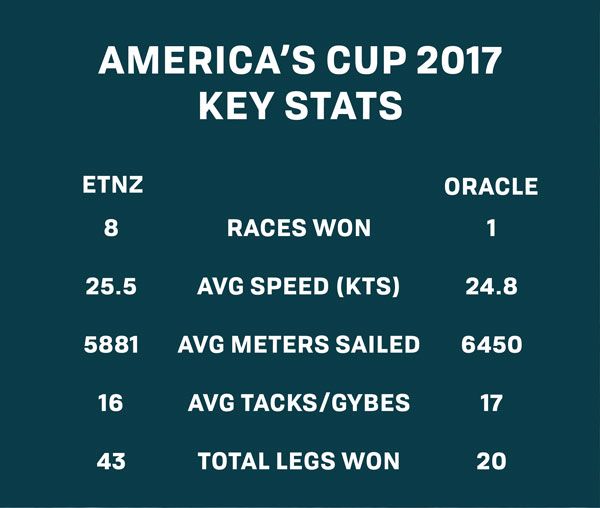 Hardware aside, when it came down to the nitty gritty of sailing the boat, Burling unleashed when it counted, owning Spithill in all but one of the final’s races. He had foxed throughout the challenger series by withholding his pre-start strategies and flattering to deceive on his true abilities. He had everybody fooled. Come the Cup proper and Burling produced his wizardry on Spithill and Oracle time and again, but it wasn’t all the 26-year-old’s handiwork. A designated onshore sailing team, featuring ETNZ veterans Murray Jones and Ray Davies, helped devise the plans to win the all-important start and worked closely in mentoring and coaching Burling and the crew. This symbiosis swept through the entire team and all of the moving parts worked together and peaked at the right time. Oracle, on the other hand, didn’t appear to have any answers and when they noticeably increased their boat speed after four races, ETNZ turned up the heat in the starter’s box and tightened their on-course manoeuvres. ‘Slick’ was a word used to describe the on-water performance time and again.
Hardware aside, when it came down to the nitty gritty of sailing the boat, Burling unleashed when it counted, owning Spithill in all but one of the final’s races. He had foxed throughout the challenger series by withholding his pre-start strategies and flattering to deceive on his true abilities. He had everybody fooled. Come the Cup proper and Burling produced his wizardry on Spithill and Oracle time and again, but it wasn’t all the 26-year-old’s handiwork. A designated onshore sailing team, featuring ETNZ veterans Murray Jones and Ray Davies, helped devise the plans to win the all-important start and worked closely in mentoring and coaching Burling and the crew. This symbiosis swept through the entire team and all of the moving parts worked together and peaked at the right time. Oracle, on the other hand, didn’t appear to have any answers and when they noticeably increased their boat speed after four races, ETNZ turned up the heat in the starter’s box and tightened their on-course manoeuvres. ‘Slick’ was a word used to describe the on-water performance time and again.
The divine culmination of Dalton and the team’s efforts began with their crucial 2013 postmortem and as the regatta grew older, it became clearer how ‘slick’ the entire ETNZ operation truly was. With humble deadpan replies at the press conferences, Burling didn’t set the microphone on fire, but this was a mere cog of processes the team did better than anyone else. There was supreme focus. One race at a time, they picked apart their opposition and as they built momentum, they built belief that they weren’t going to crumble as they had four years prior. Spithill had nothing, and Burling’s cheeky wave goodbye to Oracle after the storied hook move in race eight spoke volumes.
